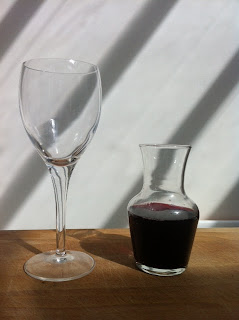So
after a succession of small accidents, I end up in full legal
possession of six bottles of 2007 Chorey-les-Beaune
from the house of Joseph Drouhin, without paying for any of them.
'This is a good day,' I tell myself. 'Half a case of flash-looking
Burgundy!' Then I add, 'But unexpected riches brings with them
responsibility. This Chorey-les-Beaune
is
in the nature of a sacred trust, especially with it being posh and
free and everything.' In other words, I must find out something about
it, show due diligence, understand what it is I'm drinking, before
knocking it off in front of a Mad
Men
re-run.
First
stop is PK, who gets agitated enough to announce that it 'Could be
bloody good', which is all the encouragement I need. After that, it's
off to Hugh Johnson's World
Atlas of Wine:
this, alarmingly, makes no mention of Chorey-les-Beaune,
so I turn to the Internet, which, even more alarmingly, tends to mark
it down as one of the smaller, thinner, less interesting,
interpretations of a Côte
de Beaune,
also noting that the (small) commune is devoid of any Premiers
or
Grands
Crus.
I
am now starting to look a gift horse in the mouth and wonder if the
cork, the vintage, the swank label, the reputable wine-maker's name,
are not guarantors of quality after all, but false friends, in which
case I am the proud possessor of nothing more than half a case of
showy dreck.
On
the other hand: the actual 2007 Chorey-les-Beaune
does
pick up a few online reviews, and these are more hopeful. Jancis
Robinson gives it 16 out of 20, which apparently makes it
'distinguished', while other critics discourse (mutedly enough) about
its 'nicely weighted fruit', how it 'hits the Burgundy spot', how it
possesses 'light redolent soft red fruits', and so on. What most are
agreed on, is that it is a Pinot Noir and that it needs to be open
for at least half an hour, better yet an hour, before consumption.
I
now experience a tremendous girding of loins and raising of
expectations as I leave my comfort zone (I had a couple of bottles of
Tesco's Vega Roja, £4.49 a bottle, the other day, and it was a hoot
from start to finish) and tackle this proper
wine with all due piety. Turns out the cork has been spot-welded to
the bottle, so there are some anxious moments as I fight with it, but
it emerges at last, and in my triumph at getting the thing out, I
pour out a glass of the intriguingly pale cherry liquid and
immediately start drinking.
And
yes, straight from the bottle, I'm getting some oil refinery, some
nail salon, and it's so scary I put the glass down with an audible
cry and turn my back on it for a good forty-five minutes. But after
that: a nice bit of interplay between tannins and acidity, curious
suggestion of cloves, a bit of turmeric, hints of antiquarian
bookshop, ending with a lingering finish in which some kind of berry
makes a showing. Not bad - but also, I announce to no-one, in a
lordly fashion, a bit wan? As if it spends its days seated on a low
divan, saying, Just
a cup a tea, please, and a slice of dry toast, nothing more.
This too chimes with what the Internet has been saying, about
thinness and lack of grunt, but there it is. Too late, now.
Underwhelmed,
I eventually get to the end of the bottle and a couple of days later
tuck into a Triade red which I've had good times with before:
perceiving it to be a nice, in-the-moment kind of grog, and quite
sophisticated by my standards. Only now, subsequent to the donnish
Chorey-les-Beaune,
it comes over as much more violently uncouth, a wine that you might
try and avoid making eye contact with on the last train home - and
this is
a problem, not least because it suggests that a single bottle of red
Burgundy has somehow transfigured my palate, rebuilt it in such a way
that an old favourite has suddenly become insufferable. 'What the
hell?' I demand of the Triade, now like a comedian who's not funny
any more.
And
sure enough, I lurch through the Triade, and a couple of days later
return to the Chorey-les-Beaune
with
a sigh of exasperated relief. A bit thin, but also a bit grown-up.
Well,
isn't that meant to be a good thing? A sign that even at this late
stage, it's possible to respond to new subtleties and bring on new
tastes? No: I can get a Triade for a under £6 a bottle on offer, if
I keep my head. Chorey-les-Beaune,
whatever
the vintage, is £15 and rising. I still possess four and a half
bottles of the stuff. After that, it's back to the bottom shelf. Tricky. If I
am to be true to the sacred trust I have burdened myself with, then self-denial must be my watchword. Which would be a first.
CJ



